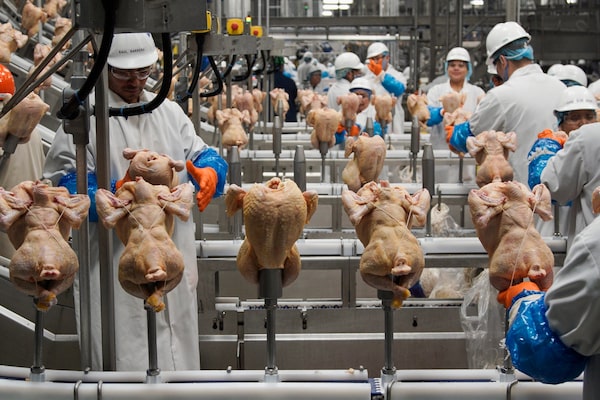
Workers process chickens at the Lincoln Premium Poultry plant in Fremont, Neb., on Dec. 12, 2019.Nati Harnik/The Associated Press
U.S. producer prices increased more than expected in March, resulting in the largest annual gain in 9½ years, likely marking the start of higher inflation as the economy reopens amid an improved public health environment and massive government funding.
The report from the Labor Department on Friday also showed solid gains in underlying producer prices last month. Inflation is expected to heat up this year driven by pent-up demand and also as the weak readings last spring drop out of the calculation. Prices tumbled early in the pandemic amid mandatory closures of non-essential businesses across many states to slow the first wave of COVID-19 infections.
Most economists and Federal Reserve officials believe higher inflation will be transitory because of labor market slack.
“Price metrics will firm on the economy, especially the service sector, reopening as well as near-term pressures from supply chain bottlenecks,” said Rubeela Farooqi, chief U.S. economist at High Frequency Economics in White Plains, New York. “However, beyond temporary effects, inflation is unlikely to keep accelerating given ample slack in the labor market.”
The producer price index for final demand jumped 1.0 per cent last month after increasing 0.5 per cent in February. In the 12 months through March, the PPI surged 4.2 per cent. That was the biggest year-on-year rise since September 2011 and followed a 2.8 per cent advance in February. Economists polled by Reuters had forecast the PPI increasing 0.5 per cent in March and jumping 3.8 per cent year-on-year.
The report was delayed after the Bureau of Labor Statistics’ website crashed. The BLS, the Labor Department’s statistics agency, said it was looking into the problems with the website.
March’s increase in producer prices was across the board. Goods prices soared 1.7 per cent, accounting for almost 60 per cent of the increase in the PPI. That was the biggest increase since December 2009 and followed a 1.4 per cent rise in February. Prices for services shot up 0.7 per cent after gaining 0.1 per cent in February.
SOLID GAINS
Fed Chair Jerome Powell said on Thursday that while he expected a surge in demand and bottlenecks in the supply chain as the economy reopens, “it seems unlikely that will change the underlying inflation psychology that has taken deep roots over the course of many years.”
Powell has repeatedly maintained that inflation will be temporary. Employment remains about 8.4 million jobs below its peak in February 2020. Though vacancies have rebounded above their pre-pandemic level, competition for jobs remains stiff, limiting workers’ ability to bargain for higher wages.
Wholesale energy prices increased 5.9 per cent accounting for 60 per cent of the broad-based rise in goods prices. Energy prices rose 6.0 per cent in February. Food prices climbed 0.5 per cent last month.
Excluding the volatile food, energy and trade services components, producer prices increased 0.6 per cent. The so-called core PPI gained 0.2 per cent in February. In the 12 months through March, the core PPI accelerated 3.1 per cent, the biggest rise since September 2018, after increasing 2.2 per cent in February.
The Fed tracks the core personal consumption expenditures (PCE) price index for its 2.0 per cent inflation target, a flexible average. The core PCE price index is at 1.5 per cent.
In March, wholesale core goods prices shot up 0.9 per cent after gaining 0.3 per cent in February.
Healthcare costs rose 0.2 per cent after dipping 0.1 per cent in the prior month. Portfolio management fees rebounded 1.6 per cent after dropping 1.1 per cent in February. Those healthcare and portfolio management costs feed into the core PCE price index.
Be smart with your money. Get the latest investing insights delivered right to your inbox three times a week, with the Globe Investor newsletter. Sign up today.